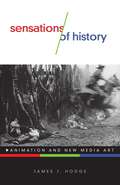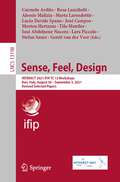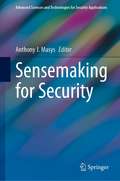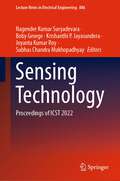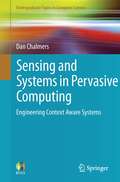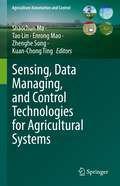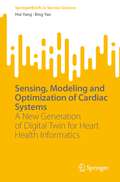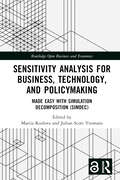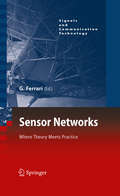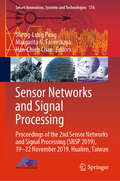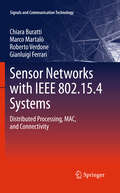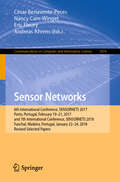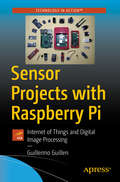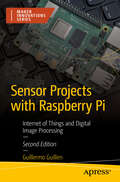- Table View
- List View
Sensations of History: Animation and New Media Art (Electronic Mediations #57)
by James J. HodgeA phenomenological investigation into new media artwork and its relationship to history What does it mean to live in an era of emerging digital technologies? Are computers really as antihistorical as they often seem? Drawing on phenomenology&’s investigation of time and history, Sensations of History uses encounters with new media art to inject more life into these questions, making profound contributions to our understanding of the digital age in the larger scope of history.Sensations of History combines close textual analysis of experimental new media artworks with in-depth discussions of key texts from the philosophical tradition of phenomenology. Through this inquiry, author James J. Hodge argues for the immense significance of new media art in examining just what historical experience means in a digital age. His beautiful, aphoristic style demystifies complex theories and ideas, making perplexing issues feel both graspable and intimate.Highlighting underappreciated, vibrant work in the fields of digital art and video, Sensations of History explores artists like Paul Chan, Phil Solomon, John F. Simon, and Barbara Lattanzi. Hodge&’s provocative interpretations, which bring these artists into dialogue with well-known works, are perfect for scholars of cinema, media studies, art history, and literary studies. Ultimately, Sensations of History presents the compelling case that we are not witnessing the end of history—we are instead seeing its rejuvenation in a surprising variety of new media art.
Sense, Feel, Design: INTERACT 2021 IFIP TC 13 Workshops, Bari, Italy, August 30 – September 3, 2021, Revised Selected Papers (Lecture Notes in Computer Science #13198)
by José Abdelnour Nocera Stefan Sauer Alessio Malizia Carmelo Ardito José Campos Rosa Lanzilotti Marta Larusdottir Lucio Davide Spano Morten Hertzum Tilo Mentler Lara Piccolo Gerrit van der VeerThis book contains a series of revised papers selected from 7 workshops organized by 18th IFIP TC 13 International Conference on Human-Computer Interaction, INTERACT 2021, which was held in September 2021 in Bari, Italy. The 15 papers included in this volume were carefully reviewed and selected from 30 submissions. They show the design of interactive technologies addressing one or more United Nations' Sustainable Development Goals, to deal with evolving contexts of use in today’s and future application domains and its influence on human-centered socio-technical system design and devel-opment practice, share educational resources and approaches to support the process of teaching and learning HCI Engineering (HCI-E), share educational resources and approaches to support the process of teaching and learning HCI Engineering (HCI-E), and address and discuss geopolitical issues in Human-Computer Interaction as a field of knowledge and practice.
Sensemaking for Security (Advanced Sciences and Technologies for Security Applications)
by Anthony J. MasysThis book presents sensemaking strategies to support security planning and design. Threats to security are becoming complex and multifaceted and increasingly challenging traditional notions of security. The security landscape is characterized as ‘messes’ and ‘wicked problems’ that proliferate in this age of complexity. Designing security solutions in the face of interconnectedness, volatility and uncertainty, we run the risk of providing the right answer to the wrong problem thereby resulting in unintended consequences. Sensemaking is the activity that enables us to turn the ongoing complexity of the world into a “situation that is comprehended explicitly in words and that serves as a springboard into action” (Weick, Sutcliffe, Obstfeld, 2005). It is about creating an emerging picture of our world through data collection, analysis, action, and reflection. The importance of sensemaking to security is that it enables us to plan, design and act when the world as we knew it seems to have shifted. Leveraging the relevant theoretical grounding and thought leadership in sensemaking, key examples are provided, thereby illustrating how sensemaking strategies can support security planning and design. This is a critical analytical and leadership requirement in this age of volatility, uncertainty, complexity and ambiguity that characterizes the security landscape. This book is useful for academics, graduate students in global security, and government and security planning practitioners.
Sensing Emotions
by Martijn Krans Martin Ouwerkerk Joyce WesterinkIn the future, products and machines will know how we feel and how to adapt to those feelings. This book analyzes the influence of specific everyday situations and contexts on the emotional state of people and ways this will impact future user experience.
Sensing Machines: How Sensors Shape Our Everyday Life
by Chris SalterHow we are tracked, surveilled, tantalized, and seduced by machines ranging from smart watches and Roombas to immersive art installations.Sensing machines are everywhere in our world. As we move through the day, electronic sensors and computers adjust our thermostats, guide our Roombas, count our steps, change the orientation of an image when we rotate our phones. There are more of these electronic devices in the world than there are people—in 2020, thirty to fifty billion of them (versus 7.8 billion people), with more than a trillion expected in the next decade. In Sensing Machines, Chris Salter examines how we are tracked, surveilled, tantalized, and seduced by machines ranging from smart watches and mood trackers to massive immersive art installations. Salter, an artist/scholar who has worked with sensors and computers for more than twenty years, explains that the quantification of bodies, senses, and experience did not begin with the surveillance capitalism practiced by Facebook, Amazon, Netflix, and Google but can be traced back to mathematical and statistical techniques of the nineteenth century. He describes the emergence of the &“sensed self,&” investigating how sensor technology has been deployed in music and gaming, programmable and immersive art environments, driving, and even eating, with e-tongues and e-noses that can taste and smell for us. Sensing technology turns our experience into data; but Salter&’s story isn&’t just about what these machines want from us, but what we want from them—new sensations, the thrill of the uncanny, and magic that will transport us from our daily grind.
Sensing Technologies for Field and In-House Crop Production: Technology Review and Case Studies (Smart Agriculture #7)
by Zhao Zhang Man Zhang Han Li Wenyi Sheng Ruicheng QiuThis book focuses on state-of-the-art sensing and automation technologies for field crops and in-house product production and provides a lot of innovative knowledge on image processing, AI algorithms and applications in agriculture, and robotics. This book provides undergraduate or graduate students with take-away knowledge for unmanned agricultural production, including but not limited to corn disease detection, wheat head detection and counting, and soil nutrient condition monitoring. The first three chapters focus on reviewing plant phenotyping sensing technology and robotics and soil nutrient monitoring, followed by in-house crop sensing robotics. Then two case studies on corn and the other two case studies on wheat are presented.
Sensing Technology: Proceedings of ICST 2022 (Lecture Notes in Electrical Engineering #886)
by Subhas Chandra Mukhopadhyay Krishanthi P. Jayasundera Boby George Joyanta Kumar Roy Nagender Kumar SuryadevaraThis book gathers the latest advances, innovations, and applications in the field of sensing technology, as presented by international researchers and engineers at the 14th International Conference on Sensing Technology (ICST), held in Chennai, India on January 17-19, 2022. Contributions include a wide range of topics such as: vision sensing, sensor signal processing, sensors phenomena and modelling, sensor characterization, smart sensors and sensor fusion, electromagnetic, chemical and physical sensors, electronic nose technology, biosensors, nano sensors, wireless sensors and WSN, Internet of Things, optical sensors, sensor arrays, intelligent sensing, Internet-based and remote data acquisition. The contributions, which were selected by means of a rigorous international peer-review process, present a wealth of exciting ideas that will open novel research directions and foster multidisciplinary collaboration among different specialists.
Sensing Technology: Proceedings of ICST'15 (Lecture Notes in Electrical Engineering #1035)
by Subhas Chandra Mukhopadhyay Krishanthi P. Jayasundera Boby George Nagender Kumar SuryadevaraThis book gathers the latest advances, innovations, and applications in the field of sensing technology, as presented by international researchers and engineers at the 15th International Conference on Sensing Technology (ICST), held in Sydney, Australia on December 5–7, 2022. Contributions include a wide range of topics such as: vision sensing, sensor signal processing, sensors phenomena and modelling, sensor characterization, smart sensors and sensor fusion, electromagnetic, chemical and physical sensors, electronic nose technology, biosensors, nano sensors, wireless sensors and WSN, Internet of Things, optical sensors, sensor arrays, intelligent sensing, Internet-based and remote data acquisition. The contributions, which were selected by means of a rigorous international peer-review process, present a wealth of exciting ideas that will open novel research directions and foster multidisciplinary collaboration among different specialists.
Sensing Vehicle Conditions for Detecting Driving Behaviors (Springerbriefs In Electrical And Computer Engineering)
by Yingying Chen Jiadi Yu Xiangyu XuThis SpringerBrief begins by introducing the concept of smartphone sensing and summarizing the main tasks of applying smartphone sensing in vehicles. Chapter 2 describes the vehicle dynamics sensing model that exploits the raw data of motion sensors (i.e., accelerometer and gyroscope) to give the dynamic of vehicles, including stopping, turning, changing lanes, driving on uneven road, etc. Chapter 3 detects the abnormal driving behaviors based on sensing vehicle dynamics. Specifically, this brief proposes a machine learning-based fine-grained abnormal driving behavior detection and identification system, D3, to perform real-time high-accurate abnormal driving behaviors monitoring using the built-in motion sensors in smartphones.As more vehicles taking part in the transportation system in recent years, driving or taking vehicles have become an inseparable part of our daily life. However, increasing vehicles on the roads bring more traffic issues including crashes and congestions, which make it necessary to sense vehicle dynamics and detect driving behaviors for drivers. For example, sensing lane information of vehicles in real time can be assisted with the navigators to avoid unnecessary detours, and acquiring instant vehicle speed is desirable to many important vehicular applications. Moreover, if the driving behaviors of drivers, like inattentive and drunk driver, can be detected and warned in time, a large part of traffic accidents can be prevented. However, for sensing vehicle dynamics and detecting driving behaviors, traditional approaches are grounded on the built-in infrastructure in vehicles such as infrared sensors and radars, or additional hardware like EEG devices and alcohol sensors, which involves high cost. The authors illustrate that smartphone sensing technology, which involves sensors embedded in smartphones (including the accelerometer, gyroscope, speaker, microphone, etc.), can be applied in sensing vehicle dynamics and driving behaviors. Chapter 4 exploits the feasibility to recognize abnormal driving events of drivers at early stage. Specifically, the authors develop an Early Recognition system, ER, which recognize inattentive driving events at an early stage and alert drivers timely leveraging built-in audio devices on smartphones. An overview of the state-of-the-art research is presented in chapter 5. Finally, the conclusions and future directions are provided in Chapter 6.
Sensing and Artificial Intelligence Solutions for Food Manufacturing
by Daniel HefftThis book gives readers a practical introduction into machine learning and sensing techniques, their design and ultimately specific applications that could improve food production. It shows how these sensing and computing systems are suitable for process implementation in food factories. This book starts by giving the reader an overview of the historic structures of food manufacturing standards and how they defined today’s manufacturing. It is followed by a topical introduction for professionals in the food industries in topics such as AI, machine learning, and neural networks. It also includes an explanation of the different sensor systems and their basic principles. It shows how these sensing and computing systems are suitable for process implementation in food factories and what types of sensing systems have already been proven to deliver benefit to the food manufacturing industries. The authors also discuss issues around food safety, labelling, and traceability and how sensing and AI can help to resolve issues. They also use case studies and specific examples that can show the benefit of such technologies compared to current approaches. This book is a practical introduction and handbook for students, food engineers, technologists and process engineers on the benefits and challenges around modern manufacturing systems following Industry 4.0 approaches.
Sensing and Systems in Pervasive Computing
by Dan ChalmersFocus on issues and principles in context awareness, sensor processing and software design (rather than sensor networks or HCI or particular commercial systems). Designed as a textbook, with readings and lab problems in most chapters. Focus on concepts, algorithms and ideas rather than particular technologies.
Sensing of Non-Volatile Memory Demystified
by Swaroop GhoshThis book introduces readers to the latest advances in sensing technology for a broad range of non-volatile memories (NVMs). Challenges across the memory technologies are highlighted and their solutions in mature technology are discussed, enabling innovation of sensing technologies for future NVMs. Coverage includes sensing techniques ranging from well-established NVMs such as hard disk, flash, Magnetic RAM (MRAM) to emerging NVMs such as ReRAM, STTRAM, FeRAM and Domain Wall Memory will be covered.
Sensing, Data Managing, and Control Technologies for Agricultural Systems (Agriculture Automation and Control)
by Tao Lin Shaochun Ma Enrong Mao Zhenghe Song Kuan-Chong TingAgricultural automation is the emerging technologies which heavily rely on computer-integrated management and advanced control systems. The tedious farming tasks had been taken over by agricultural machines in last century, in new millennium, computer-aided systems, automation, and robotics has been applied to precisely manage agricultural production system. With agricultural automation technologies, sustainable agriculture is being developed based on efficient use of land, increased conservation of water, fertilizer and energy resources. The agricultural automation technologies refer to related areas in sensing & perception, reasoning & learning, data communication, and task planning & execution. Since the literature on this diverse subject is widely scattered, it is necessary to review current status and capture the future challenges through a comprehensive monograph.In this book we focus on agricultural automation and provide critical reviews of advanced control technologies, their merits and limitations, application areas and research opportunities for further development. This collection thus serves as an authoritative treatise that can help researchers, engineers, educators, and students in the field of sensing, control, and automation technologies for production agriculture.
Sensing, Modeling and Optimization of Cardiac Systems: A New Generation of Digital Twin for Heart Health Informatics (SpringerBriefs in Service Science)
by Hui Yang Bing YaoThis book reviews the development of physics-based modeling and sensor-based data fusion for optimizing medical decision making in connection with spatiotemporal cardiovascular disease processes. To improve cardiac care services and patients’ quality of life, it is very important to detect heart diseases early and optimize medical decision making. This book introduces recent research advances in machine learning, physics-based modeling, and simulation optimization to fully exploit medical data and promote the data-driven and simulation-guided diagnosis and treatment of heart disease. Specifically, it focuses on three major topics: computer modeling of cardiovascular systems, physiological signal processing for disease diagnostics and prognostics, and simulation optimization in medical decision making. It provides a comprehensive overview of recent advances in personalized cardiac modeling by integrating physics-based knowledge of the cardiovascular system with machine learning and multi-source medical data. It also discusses the state-of-the-art in electrocardiogram (ECG) signal processing for the identification of disease-altered cardiac dynamics. Lastly, it introduces readers to the early steps of optimal decision making based on the integration of sensor-based learning and simulation optimization in the context of cardiac surgeries. This book will be of interest to researchers and scholars in the fields of biomedical engineering, systems engineering and operations research, as well as professionals working in the medical sciences.
Sensitivity Analysis for Business, Technology, and Policymaking: Made Easy with Simulation Decomposition (SimDec) (Routledge Open Business and Economics)
by Mariia Kozlova Julian Scott YeomansSimDec is a revolution in decision-making support. SimDec “teases out” inherent cause-and-effect relationships and reveals the intricacy of relationships between sets of input and output variables. At its core, SimDec is an amalgamation of uncertainty and global sensitivity analysis with an innovative visualization technique. While straightforward and elegant, this novel approach significantly enhances the analytical capabilities of users by readily exposing seemingly, a priori, counterintuitive behaviours so that they can be readily understood by both technical specialists and non-technical users alike.This book is the first to articulate the ubiquitous applicability of SimDec and has been written by the leading proponents of the technique. The book provides the necessary background to fully understand the underlying approach and then demonstrates its applicability to a wide spectrum of fields, such as finance, entrepreneurship, energy, 3D manufacturing, geology, the environment, engineering, public policy, and even superconducting magnets. To facilitate as widespread adoption and penetration of SimDec as possible, all supporting computer codes are available, open-source, in Python, Julia, R, and Matlab.The innovative material will be of primary benefit to practitioners and researchers analyzing data from the social sciences, business, science, engineering, mathematics, and computing.The Open Access version of this book, available at http://www.taylorfrancis.com, has been made available under a Creative Commons [Attribution-Non Commercial-No Derivatives (CC-BY-NC-ND)] 4.0 license.
Sensitivity Analysis for Neural Networks
by Wing W. Ng Daming Shi Ian Cloete Daniel S. YeungArtificial neural networks are used to model systems that receive inputs and produce outputs. The relationships between the inputs and outputs and the representation parameters are critical issues in the design of related engineering systems, and sensitivity analysis concerns methods for analyzing these relationships. Perturbations of neural networks are caused by machine imprecision, and they can be simulated by embedding disturbances in the original inputs or connection weights, allowing us to study the characteristics of a function under small perturbations of its parameters. This is the first book to present a systematic description of sensitivity analysis methods for artificial neural networks. It covers sensitivity analysis of multilayer perceptron neural networks and radial basis function neural networks, two widely used models in the machine learning field. The authors examine the applications of such analysis in tasks such as feature selection, sample reduction, and network optimization. The book will be useful for engineers applying neural network sensitivity analysis to solve practical problems, and for researchers interested in foundational problems in neural networks.
Sensor Data Analytics for Intelligent Healthcare Delivery (Advances in Digital Technologies for Smart Applications)
by G. S. KarthickThis book explores the transformative potential of sensor data analytics in healthcare, focusing on both real‑time and streaming analytics applications in clinical and non‑clinical environments. It introduces the foundations of sensor data collection and analytics, delving into data acquisition techniques, mining challenges, and the integration of wearable technologies. It addresses key methodologies and real‑world use cases, illustrating how sensor data can improve healthcare delivery, optimize operations, and enhance patient outcomes. It includes topics from algorithmic approaches to practical implementations across a variety of medical domains.Key Features: Covers fundamental concepts of sensor data acquisition, preprocessing, and real‑time analysis for healthcare systems. Examines the role of wearables in continuous monitoring and their analytics use in clinical workflows. Addresses the challenges and techniques for handling streaming data in dynamic healthcare environments. Explores machine learning and data mining algorithms tailored to healthcare sensor data. Provides examples across hospital operations, patient monitoring, diagnostics, and healthcare management. This book is for researchers and practitioners in data science, healthcare informatics, biomedical engineering, and healthcare management.
Sensor Networks
by Gianluigi FerrariThis book collects very recent results in the realm of sensor networking. In particular, it links the theory of sensor networking with practical and implementation aspects. Such, it highlights how sensor networking represents a very interesting research/application area, allowing a researcher to apply his theories and a practitioner to "see" the theories behind his/her used technologies.
Sensor Networks and Signal Processing: Proceedings of the 2nd Sensor Networks and Signal Processing (SNSP 2019), 19-22 November 2019, Hualien, Taiwan (Smart Innovation, Systems and Technologies #176)
by Margarita N. Favorskaya Han-Chieh Chao Sheng-Lung PengThis book offers a collection of high-quality research papers presented at the 2nd International Conference on Sensor Networks and Signal Processing (SNSP 2019), held in Taiwan on November 19–22, 2019. It presents novel contributions in the areas of sensor and actuator networks, wireless networks, networking and protocols, security and privacy, wireless communications, distributed algorithms, Internet of Things, system modeling and performance analysis, fault tolerance/diagnostics, information management, data mining and analysis, embedded systems design, signal theory, signal and image processing, detection and estimation, spectral analysis, software developments, pattern recognition, data processing, remote sensing, big data, machine learning, information and coding theory, and industrial applications.
Sensor Networks with IEEE 802.15.4 Systems
by Roberto Verdone Gianluigi Ferrari Marco Martalo' Chiara BurattiThis book presents a simple, yet complete, approach to the design and performance analysis of distributed processing algorithms and techniques suitable for IEEE 802.15.4 networks. In particular, the book focuses on the bottom two layers of the ISO/OSI stack (Physical and Medium Access Control), discussing also a few issue related to routing. The book is a the synergistic combination of signal processing aspects on the one hand and MAC and connectivity issues on the other hand. The goal of the book is to clearly link physical layer aspects with medium access and topology aspects, in order to provide the reader with a clear understanding of how to approach the design of proper distributed signal processing and medium access algorithms in this context.
Sensor Networks: 6th International Conference, SENSORNETS 2017, Porto, Portugal, February 19-21, 2017, and 7th International Conference, SENSORNETS 2018, Funchal, Madeira, Portugal, January 22-24, 2018, Revised Selected Papers (Communications in Computer and Information Science #1074)
by César Benavente-Peces Nancy Cam-Winget Eric Fleury Andreas AhrensThis book constitutes the refereed proceedings of the 6th International Conference, SENSORNETS 2017, Porto, Portugal, held in February 2017, and the 7th International Conference, SENSORNETS 2018, Funchal, Madeira, Portugal, held in January 2018. The 18 full papers presented were carefully reviewed and selected from 67 submissions. The papers cover the following topics: sensor networks, including hardware of sensor networks, wireless communication protocols, sensor networks software and architectures, wireless information networks, data manipulation, signal processing, localization and object tracking through sensor networks, obstacles, applications and uses.
Sensor Networks: 9th International Conference, SENSORNETS 2020, Valletta, Malta, February 28–29, 2020, and 10th International Conference, SENSORNETS 2021, Virtual Event, February 9–10, 2021, Revised Selected Papers (Communications in Computer and Information Science #1674)
by Nirwan Ansari César Benavente-Peces Andreas Ahrens RangaRao Venkatesha PrasadThis book constitutes selected and revised papers of the 9th International Conference, SENSORNETS 2020, Valletta, Malta, held in February 2020, and the 10th International Conference, SENSORNETS 2021, held virtually in February 2021. The 7 full papers presented were carefully reviewed and selected from 60 submissions. They focus in all aspects of sensor networks, including hardware of sensor networks, wireless communication protocols, sensor networks software, hardware and architectures, wireless information networks, channel characterization, data manipulation, signal processing, localization and object tracking through sensor networks, modelling and simulation, applications and uses.
Sensor Projects with Raspberry Pi: Internet of Things and Digital Image Processing
by Guillermo GuillenStart solving world issues by beginning small with simple Rasperry Pi projects. Using a free IoT server; tackle fundamental topics and concepts behind the Internet of Things. Image processing and sensor topics aren’t only applicable to the Raspberry Pi. The skills learned in this book can go own to other applications in mobile development and electrical engineering. Start by creating a system to detect movement through the use of a PIR motion sensor and a Raspberry Pi board. Then further your sensor systems by detecting more than simple motion. Use the MQ2 gas sensor and a Raspberry Pi board as a gas leak alarm system to detect dangerous explosive and fire hazards. Train your system to send the captured data to the remote server ThingSpeak. When a gas increase is detected beyond a limit, then a message is sent to your Twitter account. Having started with ThingSpeak, we’ll go on to develop a weather station with your Raspberry Pi. Using the DHT11 (humidity and temperature sensor) and BMP085 (barometric pressure and temperature sensor) in conjunction with ThingSpeak and Twitter, you can receive realtime weather alerts from your own meterological system!Finally, expand your skills into the popular machine learning world of digital image processing using OpenCV and a Pi. Make your own object classifiers and finally manipulate an object by means of an image in movement. This skillset has many applications, ranging from recognizing people or objects, to creating your own video surveillance system.With the skills developed in this book, you will have everything you need to work in IoT projects for the Pi. You can then expand your skills out further to develop mobile projects and delve into interactive systems such as those found in machine learning.What You'll LearnWork with ThingSpeak to receive Twitter alerts from your systemsCultivate skills in processing sensor inputs that are applicable to mobile and machine learning projects as wellIncorporate sensors into projects to make devices that interact with more than just codeWho This Book Is ForHobbyists and makers working robotics and Internet of Things areas will find this book a great resource for quick but expandable projects. Electronics engineers and programmers who would like to expand their familiarity with basic sensor projects will also find this book helpful.
Sensor Projects with Raspberry Pi: Internet of Things and Digital Image Processing (Maker Innovations Series)
by Guillermo GuillenUse Python to develop Rasperry Pi projects to solve common digital image processing and IoT problems. Using a free IoT server you’ll tackle fundamental topics and concepts behind theses two areas. This second edition includes new content on Artificial Intelligence and updated sensor guidance to help you better explore virtual animations, create a homemade spectrometer, and master object classification with Edge Impulse. Start by creating a system to detect movement with a PIR motion sensor and a Raspberry Pi board. Use the MQ2 gas sensor and a Raspberry Pi board as a gas leak alarm system to detect dangerous explosive and fire hazards. Then train your system to send the captured data to the remote server ThingSpeak. You’ll also develop a weather station with your Raspberry Pi. Using the DHT11 (humidity and temperature sensor) and BMP (barometric pressure and temperature sensor) in conjunction with ThingSpeak and X, you can receive real time weather alerts from your own meterological system! Spectral sensers used with the Raspberry Pi include the AS7262 (six colors), and AS7263 (near infrared) for the construction of a filter spectrometer, sensing colored solutions, and assessing plant foliage health. Finally, expand your skills into the popular machine learning world of digital image processing using OpenCV and a Pi. Make your own object classifiers and finally manipulate an object by means of an image in movement. This skillset has many applications, ranging from recognizing people or objects, to creating your own video surveillance system. With the skills gained from Sensor Projects with Raspberry Pi, you'll be well-equipped to explore other applications in mobile development and electrical engineering as well. What You'll Learn Work with ThingSpeak to receive X alerts from your systems. Cultivate skills in processing sensor inputs that are applicable to mobile and machine learning projects. Incorporate sensors into projects to make interactive devices. Experiment with virtual scenarios and objects. Create Python and Pygame games that contain virtual scenarios and animations. Detect colored solutions and assess the plant foliage health. Who This Book Is For Hobbyists and makers working with robotics and IoT. Electronic engineers and programmers who would like to expand their familiarity with basic sensor projects.
Sensor Systems and Software
by Eiman Kanjo Dirk TrossenThis book constitutes the thoroughly refereed post-conference proceedings of the 5th International Conference on Sensor Systems and Software, S-Cube 2014, held in Coventry, UK, in October 2014. The 12 revised full papers presented were selected from 16 submissions and cover technologies for wireless sensor networks, including security protocols, middleware, analysis tools and frameworks.
